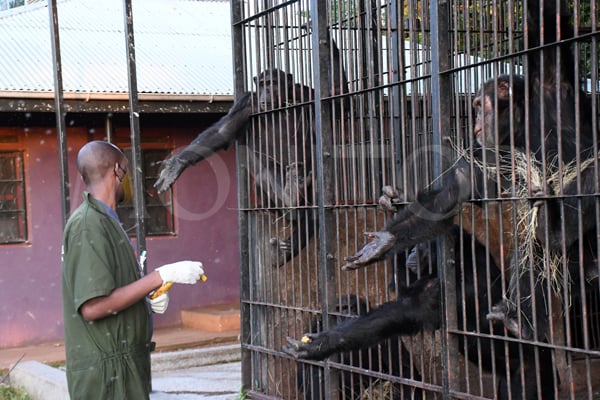Prime
Ngamba Island Chimpanzee sanctuary, man’s interesting ape cousins

A man feeds chimps at Ngamba Island Chimpanzee Sanctuary. PHOTO/EDGAR BATTE
What you need to know:
- To spend a night, a couple parts with Shs1.5m, a fee that includes them taking part in monitoring the health and behavior of the chimpanzees and thereafter record in the visitor chimp records observations book.
Chimpanzees have 98.7 percent human DNA and it is clear to see when you get to watch them interact. Gentle Namukisa curdles and plays with the agile Ruparelia, hugging and rolling on the ground as well as taking turns to groom one another.
The two chimpanzees are admirable friends. Like the 52 orphaned chimpanzees, Namukisa was rescued from illegal pet collectors and calls Ngamba Island Chimpanzee Sanctuary her home.
The island is one of 985 on Lake Victoria, the world’s largest tropical lake. Tourists are welcomed to the island to watch the chimpanzees during feeding time, twice a day, at 11 a.m and at 2:30 p.m.
You can book through the sanctuary’s offices in Entebe, on Plot 1 Bank Close. A return trip to Water Front Beach in Entebe, costs Shs252, 000 which also includes guide fees.
The guides are knowledgeable and are happy to share and also answer questions from tourists as you watch the chimpanzees feeding. The cost also includes lunch, a cruise on the lake, and a swim for those that might want to at the Equator, unique for the fact that the line divides the earth into northern and southern hemispheres and constituting the parallel of latitude 0°.
It runs through some eleven countries around the world. The boat captain will stop at the equator for travelers who might also want to take photographs as the waves gently hit the boat.
On arrival at the island, you will be welcomed by a guide who will give you an overview of the expected experience and facts about the chimps. You can carry a digital camera or have your phone ready to capture photographs and videos of the apes as they feed, run around, hug one another, chant, make pant-hoots, grunts and barks.

Mealtimes bring out quite a lot of character traits, so be sure to observe the bullies, the calm, and the peacemakers. They converge to get the meal but spend much of their day out on 95 acres of forested land.
The sanctuary is a Non-Profit Organisation that was established in 1998 and largely depends on support from donors. It has accommodation facilities and guests can have an overnight stay and get to wake up and enjoy the morning coffee as they wait for the chimps to get up from their hammocks to prepare for their usual day that starts with leaving the holding facility to the forest for their breakfast.
Residents get the opportunity to see them have breakfast at 8 am on a raised platform. The other perk for residents is participation in the chimpanzees’ environmental enrichment program where you will be tasked to challenge the chimps’ critical thinking abilities to help them stay healthy, physically and mentally.
To spend a night, a couple parts with Shs1.5m, a fee that includes them taking part in monitoring the health and behavior of the chimpanzees and thereafter record in the visitor chimp records observations book.
What is more, is you get to view the feeding of the chimps as they feed on the water edges as well as watch behind-the-scenes activities like chimp food preparations and facility cleaning.
John H, tourism from Westmount, Canada, writes, “The concept of the Sanctuary is honorable. The setup on the island is both professional and interesting. It is all about the chimps, and it is interesting to learn and see them. We also had a very nice lunch at the island dining room. The trick is the boat ride for about 45 minutes out into Lake Victoria. It is a nice escape, but one also needs to be comfortable on the open water (in case of motion sickness).”
As the day ends, you can join the team of caregivers for an exclusive sunset cruise on which you will see fishermen cast their nets, fishing villages as they wind down the day, and of course the golden circular site of nature’s eye- the sun- going to sleep.
If your heartbeat for the community, you can visit the neighboring rural, fishing communities. Be sure to watch a number of bird species while on a cruise, including the colorfully beautiful African Fish Eagle.
There are more birds to see while at the island as well the rather shy monitor lizards, otters, and more. The caregivers will be happy to guide you to one of the viewpoints where you will see them feed.

But those are little-known creatures, Ngamba’s big celebrities are the chimps who connect differently, almost individually with the caregivers. On the whole, juveniles and the female chimps take first priority.
“Normally, we start by feeding the juveniles and females because the male chimpanzees tend to want everything for themselves so they are the last ones to the breakfast table,” explains Innocent Ampeire, a caregiver who also doubles as the assistant sanctuary manager.
Paul Nyenje, another caregiver, recalls starting his journey at the sanctuary on a challenging note. “I was challenged by Mawa and Asega. On my first day as a volunteer, Mawa hit me with a stone. I looked at him and like humans, I realized he is a bully. I got to appreciate him for who is. I have come to appreciate and understand the lifestyle of chimpanzees. They plan, communicate and I have learned a lot from them,” Nyenje, who started as a volunteer in 2005, explains.
After 15 years, he has come to appreciate just how political the apes are, just like it is among human beings. Kisembo is the current leader and for 15 years, Mawa has been opposed to the leadership, albeit in vain. To maintain harmony, he has been confined to solitary.





